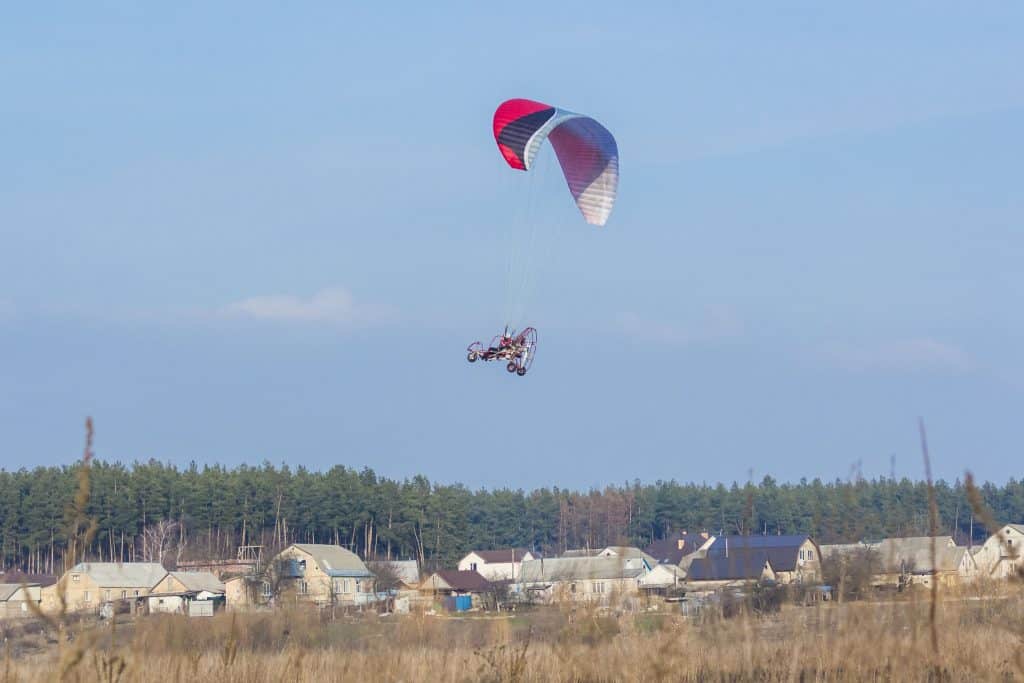
In my time studying paramotors, I’ve often asked myself the question, “How far can a Paramotor fly?” Perhaps you’ve asked yourself this question as well when contemplating these flying masterpieces.
So, how far can a paramotor fly? The farthest a paramotor can reasonably be expected to fly is around 200 miles, but most paramotor flights will only cover around 10 miles. Some paramotor pilots can fly hundreds of miles by taking pit stops to fuel back up while traveling on longer journeys.
Perhaps you are now wondering to yourself, “How can I maximize my own air time?”, or perhaps you have questions concerning the overall time spent traveling that distance, and what sacrifices need to be made in the design of the paramotor in order to go that far.
I’m here to answer some of those questions.
How to Fly a Paramotor as Far as Possible
There are a few things that are vital to know when you want to fly a good long distance. One of the most important things to have a good base knowledge about is the engine. This is where the trust of the paramotor comes from, and will largely determine how fast you can go.
The next thing you’ll want an understanding of is what wing to get and how to use it. There are certain wings that work better in some situations than others. Larger wings are better in turbulent weather, while smaller wings are better for calmer weather as far as speed and distance go.
Another thing that we’re going to talk about is having a good comprehension of the manner in which you fly your paramotor. The way you pilot your paramotor is what really brings everything together.
You want to have a fuel-efficient
engin e.
You can have the most fuel efficient engine with the most thrust, have the fastest wing out there, and waste their capabilities if you don’t know how to fly for distance.
All of the things we’re going to talk about should be tailored to do two things. Move you where you need to go and save fuel while doing it. You want to have a fuel-efficient engine that still does the job of moving you from point A to point B.
You want a wing that cuts through the air like a knife, but also a wing that makes it easy to remain at altitude. You want to fly for movement, but also keep in mind that you have limited fuel, and hot rodding it all the way won’t work.
Engine
When considering an engine, it’s typically a choice between gas guzzling powerhouses, or fuel efficient weak sauce engines that don’t have the power to really move you anywhere.
Electric Engines can be thrown out the window right off the bat, and four-stroke engines can be looked past as well. The type of engine with the best power to fuel efficiency ratio is the two-stroke engine.
Of the two-stroke engines, one of the most (if not the most) fuel efficient of all the engines on the market is the Miniplane Top 80. When looking at engines, fuel efficiency, or the lasting endurance scales much more potently than power does.
Consider this: if you were to bet on a runner to win a race, would you bet on the runner who can squat 400 pounds once, or 200 pounds 20 times?
The Miniplane Top 80 uses 1.5 to 2.5 liters of fuel per hour, making it much better than the typical 4 liters per hour. Because most paramotors only have a 3.8-gallon tank for fuel, that limits them severely, but with only using 1.5 liters an hour, you could stay in the air for 9.5 hours.
Distance vs Flight Time
So, using the Miniplane Top 80 and using fuel sparingly, you can squeeze out around 9.5 hours. The kind of engine that you have matters very little if you can’t use the fuel that you’re burning. There are several factors that go into turning your flight time into going the distance.
These factors include the kind of wing you use, the wind direction and wind speed, and the manner in which you fly. These will all contribute to your ability to turn that gas into miles.
The Wing You Use
When buying a wing to travel distance, what you are looking for is two things, a good glide ratio, and a low amount of drag. A good glide ratio means that you don’t need as much thrust/power to stay afloat in the air, meaning less fuel consumption.
The opposite goes for drag. When there’s drag created by a wing, it slows forward momentum, meaning you need more thrust/power to stay afloat and in the air.
Consuming fuel at a faster rate is something to avoid like the plague when trying to fly for distance, so drag ought to be avoided when finding a wing for flight.
Wind Speed and Direction
The wind speed and direction that you have, as well as the wind gusts happening during the flight, can affect how far you go drastically. Paramotoring is an air sport, so wind plays a big role in all aspects of it, from launch to landing.
If you’re flying into the wind, you are not going to make nearly as much distance as you would if you were instead flying with the wind.
If you’re planning a trip, look at the wind patterns in the areas you plan on going through. It might just be worth a detour on a longer route if the wind is supporting you. You can go that much faster if conditions are right.
How to Fly

The best way to save fuel when flying is to take off, climb to 500 feet, and stay on that level, going in a straight line. This way, you don’t waste power on unneeded activities for going the distance. You have a much better range like this.
An example of unneeded activities when traveling distance is ascending or descending. The more you do this, the more thrust you will need throughout your flight, meaning you’ll have less fuel dedicated to moving forward.
The same goes for taking turns. Using fuel for turns in your flight will keep you from using that fuel for distance.
Range of a Paramotor
When calculating the range we need to take into account the fuel you are using, how fast you are going, and how long you can go.
Let’s imagine for a moment that you invest some money, and get a fabulous paramotor. It has a speed of around 40 mph, and has a fuel tank that pushes the limits of fuel capacity, and has just under 19 liters of fuel.
If you are careful with how you fly this paramotor, and it burns fuel at a rate of 1.5 liters per hour (an above standard rate of consumption in the paramotoring world), this paramotor, if flown ideally (meaning flying between 400 and 600 feet in a straight line) should be able to get to around 506 miles before needing to refuel.
Of course, a paramotor with this capability doesn’t quite exist yet. It is, however, a good example of how to calculate how far your paramotor can go. Use this equation to do your own calculations:
(Fuel Capacity/Rate of Fuel Used Per Hour) x Miles Per Hour = Miles You Can Fly
Be sure that you use the same unit of measurement with the fuel capacity and rate of fuel used. If you go with gallons, stick with gallons. If you go with liters stick with liters. Here are some useful converters if you need to convert gallons to liters or liters to gallons.
The assumption made in these calculations is that you will have the skill and ability to stay at 400- 600 feet, and also that the wind won’t start working against you. If you slip out of that range, or the wind starts working against you, you won’t quite have the numbers you are looking for.
It is also assumed that you’ll be using 1.5 liters of fuel an hour instead of the industry standard of 2-2.5. Your ride would also be cut shorter the more fuel you waste doing unnecessary turns, or tricks, etc.
However, the same can be said of the opposite assumptions that the wind won’t start up and work for you and that you won’t be able to save fuel by riding on the winds.
In reality, there are many conditions that can affect the distance you can travel. 200 miles is a conservative estimate, and one could travel insane distances with perfect conditions, but perfect conditions aren’t always attainable.
Ideally, if you want to go for distance, 200 is as far as is reasonably expected.
Related Questions:
How high can a paramotor fly? It’s possible to fly them to 15,000 feet, but the air is thin up there and it’s extremely dangerous to do that. Most paramotor flights are around 1,000 feet up. It’s generally safer to fly high than low. When flying low, you don’t have time to react to a problem before hitting the ground.
Which is safer, paramotors or paragliders? Statistics show that paramotors are safer than paragliders, with fatality rates of 1/1504 to 1/752 respectively. However, the rate of accidents with injury is relatively similar. You can read more about the differences between Paramotors and Paragliders here at our other article.
